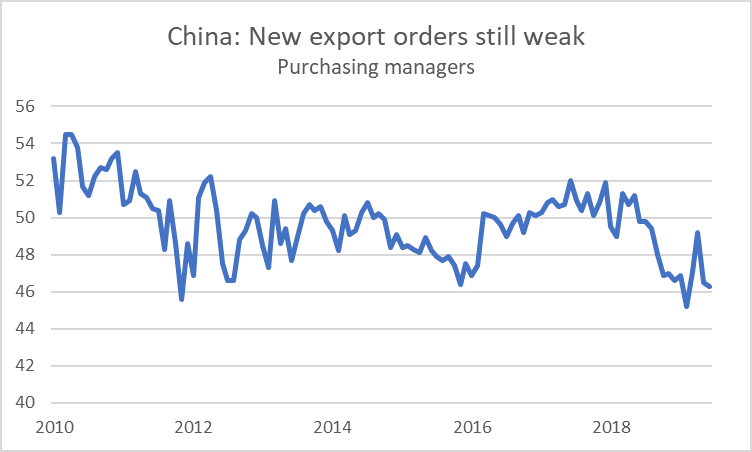The great China slowdown continues
- John Calverley
- Jul 16, 2019
- 3 min read
China's economy slowed sharply in 2018 and for nearly 12 months now the government has been working to reinvigorate it, so far without success. Signs of a lift in the spring have faded. So what is going on? First, and most important, the government is still keeping the lid on the growth of shadow bank credit, with the result that China’s private sector, including the house-building sector, is struggling. Second, the trade war is dampening exports and holding back business confidence.

Consumer spending, backed by tax cuts along with government infrastructure spending were the main drivers of Q2 GDP growth reported Monday. Business investment is weak, especially private sector investment and new housing starts. Exports are weak too with new export orders still in the doldrums.

At 6.2% y/y, GDP growth was significantly lower than the 6.4% recorded in Q1 and the 6.6% in 2018 as a whole. Can I really say ‘significant’ when it was only 2 tenths lower? Even in an economy like the US where GDP growth typically has a 2 handle the difference between 2.4% growth and 2.2% is barely significant. So, with a 6 handle it really shouldn’t be significant at all. The trouble is that these are not real numbers, only an indication. We have no idea at what rate China is really growing. It might be 5% or 4% or even lower. And very probably, if we did have the right numbers the amount of slowdown this quarter would be more than 2 tenths.

The key point is that GDP growth is slow and is not recovering as planned. The government has no easy options. Quickly settling with Trump would upset the Party because the US wants a change in China’s pro state-owned enterprise policies which is anathema to the hard-liners. In any case it is not certain that settling the trade dispute would be enough. China still faces the same problem it has struggled with for nearly 10 years now: It has too much debt but unless debt grows faster than GDP the economy slows.
As I have documented here before it is not just government debt, local authority debt or corporate debt which is high but increasingly consumer debt too. In short, the government has run out of balance sheets to ramp up. Over the last year it has again boosted central government and local government borrowing to finance more infrastructure spending. Without this, growth would have slowed even further.
So what to expect next? Easier credit to the housing sector is likely before long together with selected other measures to boost growth. The reversal of Fed policy in the last 6 months towards loosening makes it easier for China to ease monetary policy further without risking losing control of the renminbi. And perhaps there will be further tax cuts for consumers although this will raise the government budget deficit, already 4% of GDP in 2018 (and higher if local authority borrowing is included). Meanwhile the trade war looks unlikely to be settled any time soon but it may be contained as it is bad for both countries.
The government likely will not try too hard to boost growth. It recognises that it cannot keep ramping up debt. And it has made some progress over the last couple of years with the ratios to GDP stabilising. So, growth will likely stay near the current rate, whatever that is. Probably in the 3-5% range I would guess, about in line with south-east Asia. From a social/political point of view this is not too difficult to manage. The labour force is no longer increasing the way it was 20 years ago and the government has clamped down hard on dissent.
Slow growth in China is more of a problem for other countries. Many emerging countries were lifted by high commodity prices over the last 15 years due to China’s insatiable demand for raw materials. Now things are slower. And countries like Germany, Japan and Korea face weak demand for their capital goods as Chinese investment continues to slow. The great China slowdown has a long way to run yet and countries are going to have to deal with it. The shift to an easier monetary policy in the US and Europe is an early response.


Comments